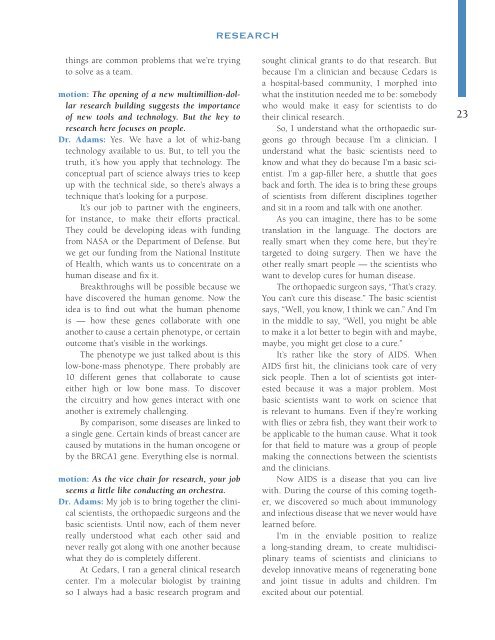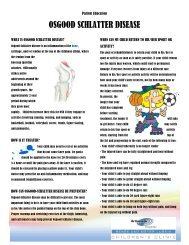“It's A Bargain” Thrift Shop - Orthopaedic Hospital
“It's A Bargain” Thrift Shop - Orthopaedic Hospital
“It's A Bargain” Thrift Shop - Orthopaedic Hospital
Create successful ePaper yourself
Turn your PDF publications into a flip-book with our unique Google optimized e-Paper software.
things are common problems that we’re trying<br />
to solve as a team.<br />
motion: The opening of a new multimillion-dollar<br />
research building suggests the importance<br />
of new tools and technology. But the key to<br />
research here focuses on people.<br />
Dr. Adams: Yes. We have a lot of whiz-bang<br />
technology available to us. But, to tell you the<br />
truth, it’s how you apply that technology. The<br />
conceptual part of science always tries to keep<br />
up with the technical side, so there’s always a<br />
technique that’s looking for a purpose.<br />
It’s our job to partner with the engineers,<br />
for instance, to make their efforts practical.<br />
They could be developing ideas with funding<br />
from NASA or the Department of Defense. But<br />
we get our funding from the National Institute<br />
of Health, which wants us to concentrate on a<br />
human disease and fix it.<br />
Breakthroughs will be possible because we<br />
have discovered the human genome. Now the<br />
idea is to find out what the human phenome<br />
is — how these genes collaborate with one<br />
another to cause a certain phenotype, or certain<br />
outcome that’s visible in the workings.<br />
The phenotype we just talked about is this<br />
low-bone-mass phenotype. There probably are<br />
10 different genes that collaborate to cause<br />
either high or low bone mass. To discover<br />
the circuitry and how genes interact with one<br />
another is extremely challenging.<br />
By comparison, some diseases are linked to<br />
a single gene. Certain kinds of breast cancer are<br />
caused by mutations in the human oncogene or<br />
by the BRCA1 gene. Everything else is normal.<br />
motion: As the vice chair for research, your job<br />
seems a little like conducting an orchestra.<br />
Dr. Adams: My job is to bring together the clinical<br />
scientists, the orthopaedic surgeons and the<br />
basic scientists. Until now, each of them never<br />
really understood what each other said and<br />
never really got along with one another because<br />
what they do is completely different.<br />
At Cedars, I ran a general clinical research<br />
center. I’m a molecular biologist by training<br />
so I always had a basic research program and<br />
research<br />
sought clinical grants to do that research. But<br />
because I’m a clinician and because Cedars is<br />
a hospital-based community, I morphed into<br />
what the institution needed me to be: somebody<br />
who would make it easy for scientists to do<br />
their clinical research.<br />
So, I understand what the orthopaedic surgeons<br />
go through because I’m a clinician. I<br />
understand what the basic scientists need to<br />
know and what they do because I’m a basic scientist.<br />
I’m a gap-filler here, a shuttle that goes<br />
back and forth. The idea is to bring these groups<br />
of scientists from different disciplines together<br />
and sit in a room and talk with one another.<br />
As you can imagine, there has to be some<br />
translation in the language. The doctors are<br />
really smart when they come here, but they’re<br />
targeted to doing surgery. Then we have the<br />
other really smart people — the scientists who<br />
want to develop cures for human disease.<br />
The orthopaedic surgeon says, “That’s crazy.<br />
You can’t cure this disease.” The basic scientist<br />
says, “Well, you know, I think we can.” And I’m<br />
in the middle to say, “Well, you might be able<br />
to make it a lot better to begin with and maybe,<br />
maybe, you might get close to a cure.”<br />
It’s rather like the story of AIDS. When<br />
AIDS first hit, the clinicians took care of very<br />
sick people. Then a lot of scientists got interested<br />
because it was a major problem. Most<br />
basic scientists want to work on science that<br />
is relevant to humans. Even if they’re working<br />
with flies or zebra fish, they want their work to<br />
be applicable to the human cause. What it took<br />
for that field to mature was a group of people<br />
making the connections between the scientists<br />
and the clinicians.<br />
Now AIDS is a disease that you can live<br />
with. During the course of this coming together,<br />
we discovered so much about immunology<br />
and infectious disease that we never would have<br />
learned before.<br />
I’m in the enviable position to realize<br />
a long-standing dream, to create multidisciplinary<br />
teams of scientists and clinicians to<br />
develop innovative means of regenerating bone<br />
and joint tissue in adults and children. I’m<br />
excited about our potential.<br />
23



